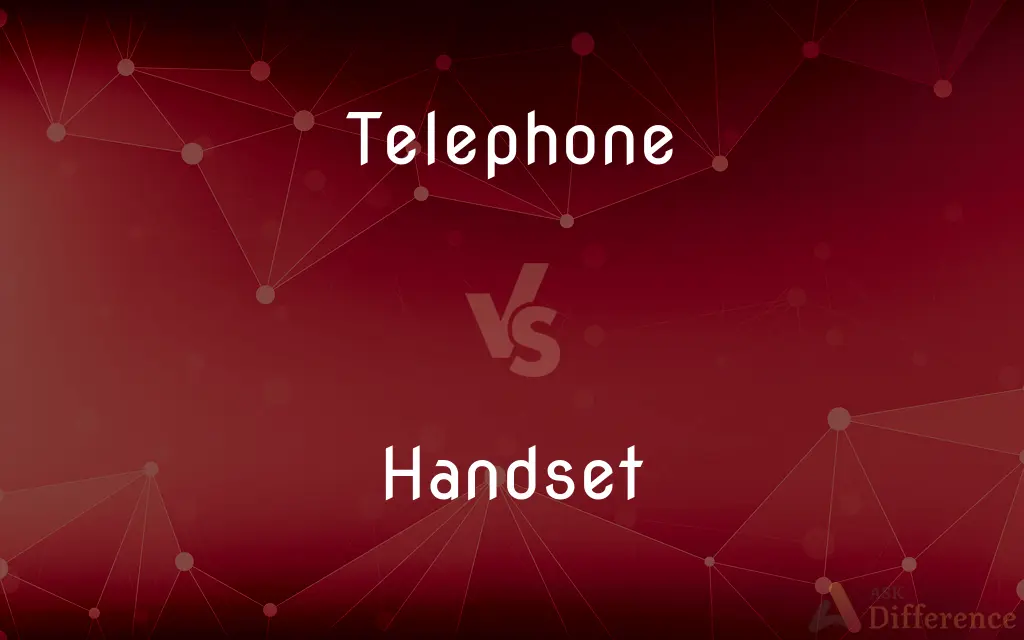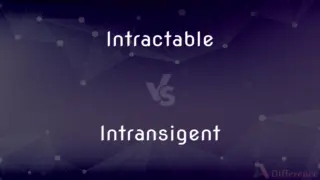Telephone vs. Handset — What's the Difference?
By Maham Liaqat & Fiza Rafique — Updated on March 30, 2024
A telephone is a communication device for transmitting voice over distances, while a handset refers to the part of the phone held in the hand, often containing the speaker and microphone.

Difference Between Telephone and Handset
Table of Contents
ADVERTISEMENT
Key Differences
The term "telephone" encompasses the entire system or device used for voice communication over distances, utilizing electrical signals to transmit sound. It includes both the hardware that makes up the phone system and the technology behind it. Whereas, a handset is a component of a telephone, specifically the part that is designed to be held in the hand during use. It typically includes the speaker and microphone, allowing the user to listen and speak without needing to be in direct contact with the phone's base or main body.
In traditional landline systems, the telephone refers to both the base, which houses the dial pad, and the handset. The base is connected to the telephone network through wiring, while the handset is connected to the base, allowing for mobility during conversation. On the other hand, in modern mobile phones, the terms blend together, as the entire device acts as both the telephone and the handset, integrating all components into a single, portable unit.
The evolution of technology has seen telephones transition from rotary dial systems to push-button and eventually to touchscreen interfaces, encompassing a wide range of functionalities beyond voice communication, such as text messaging and internet access. Conversely, the handset has remained relatively unchanged in its core function—to facilitate audio input and output though its form has evolved with design changes in telephones, from corded to cordless, and now to being a part of the smartphone's body.
Telephones are essential tools in both personal and professional communication, enabling direct interaction across vast distances. They have transformed over time to include mobile phones, which provide users with the freedom to communicate from virtually anywhere. Meanwhile, handsets have adapted to these changes, evolving from separate pieces connected by a cord to a physical part of mobile phones, reflecting the shift towards more integrated and compact devices.
The distinction between telephone and handset is most notable in traditional landline systems, where the handset is physically distinct from the base. In contrast, modern smartphones blur this distinction, embodying both functions within a single device, highlighting how advancements in technology have merged these once separate components into a unified whole.
ADVERTISEMENT
Comparison Chart
Definition
A device for transmitting voice across distances using electrical signals.
The part of a phone designed to be held in the hand, containing the speaker and microphone.
Components
May include the base, handset, dial pad, and sometimes an answering machine.
Consists of the speaker and microphone, and in traditional phones, is connected to the base by a cord.
Functionality
Provides voice communication and, in modern versions, text messaging, internet access, and more.
Facilitates audio input and output during a call.
Evolution
Has evolved from rotary and push-button landlines to mobile and smartphones.
Has evolved in form but maintained its core function, integrating into the smartphone body in modern designs.
Usage Context
Refers to the entire system or device, regardless of its form (landline or mobile).
Refers specifically to the part of the device interacting with the user's ear and mouth during a call.
Compare with Definitions
Telephone
Often includes features like voicemail.
Check the telephone for any missed calls.
Handset
May be corded or cordless in landlines.
The cordless handset needs to be recharged.
Telephone
Enables calls between users.
He left a message on the telephone answering machine.
Handset
Integral to mobile phones' design.
Smartphones integrate the handset into their overall design.
Telephone
Landline or mobile communication system.
The telephone has evolved significantly over the years.
Handset
Part of the telephone held during a call.
She picked up the handset to dial her friend.
Telephone
Part of global communication networks.
Telephones connect people across the world.
Handset
Facilitates audio during calls.
He spoke directly into the handset.
Telephone
A device for voice communication over distances.
She answered the telephone on the second ring.
Handset
Contains speaker and microphone.
The handset's speaker was not working properly.
Telephone
A telephone is a telecommunications device that permits two or more users to conduct a conversation when they are too far apart to be heard directly. A telephone converts sound, typically and most efficiently the human voice, into electronic signals that are transmitted via cables and other communication channels to another telephone which reproduces the sound to the receiving user.
Handset
A handset is a component of a telephone that a user holds to the ear and mouth to receive audio through the receiver and speak to the remote party via the built-in transmitter. In earlier telephones the transmitter was mounted directly on the telephone itself, which was attached to a wall at a convenient height or affixed to a desk stand.
Telephone
An instrument for simultaneously transmitting and receiving speech or other sounds over a distance by converting the sounds into signals that are sent to a similar instrument and converting them back into sounds.
Handset
The handle-shaped part of a telephone, containing the receiver and transmitter and often a dial or push buttons.
Telephone
To make or try to make a telephone connection with; place a call to
Telephoned the police station.
Handset
The part of a landline telephone containing both receiver and transmitter (and sometimes dial), held in the hand.
Telephone
To dial (a telephone number).
Handset
A mobile phone.
Telephone
To transmit (a message, for example) by telephone
I telephoned that I was sick and could not come to work.
Handset
A hand-held device for remote control of a piece of equipment.
Telephone
To engage in communication by telephone
She telephoned to invite us to the party.
Handset
(typography) To typeset by hand.
Handsetting type
Telephone
A telecommunication device (originally mechanical, and now electronic) used for two-way talking with another person (now often shortened to phone).
Handset
The mouthpiece and earpiece of a communications device mounted on a single handle; as, when the telephone rings, pick up the handset.
Telephone
The game of Chinese whispers.
Handset
Telephone set with the mouthpiece and earpiece mounted on a single handle
Telephone
Chinese whispers; a situation in which an initial message has been distorted and misunderstood by being passed from person to person.
Telephone
(ambitransitive) To (attempt to) contact someone using a telephone.
Telephone
(transitive) To convey (a message) via telephone.
Telephone
An instrument for reproducing sounds, especially articulate speech, at a distance.
Telephone
To convey or announce by telephone.
Telephone
Electronic equipment that converts sound into electrical signals that can be transmitted over distances and then converts received signals back into sounds;
I talked to him on the telephone
Telephone
Transmitting speech at a distance
Telephone
Get or try to get into communication (with someone) by telephone;
I tried to call you all night
Take two aspirin and call me in the morning
Common Curiosities
What defines a handset?
The part of a telephone designed to be held in the hand, usually containing the speaker and microphone.
What is a telephone?
A device used for transmitting voice across distances, capable of sending and receiving sound.
How do telephones and handsets differ?
Telephones refer to the entire device or system for voice communication, while handsets are specifically the parts held during a call.
Can a mobile phone be considered a handset?
Yes, in modern mobile phones, the entire device acts as both the telephone and the handset.
Do all telephones have a separate handset?
Not anymore; modern smartphones integrate the handset's functions into a single, portable device.
What features might a modern telephone include?
Beyond voice calls, modern telephones include text messaging, internet access, and various applications.
Is there a technological difference between telephone and handset?
Yes, the telephone encompasses the entire communication device, while the handset is specifically the part used for listening and speaking.
How have handsets evolved over time?
Handsets have evolved from being separate, corded pieces to being integrated into the body of smartphones.
Are handsets still relevant with modern smartphones?
Yes, the core function of handsets is integrated into smartphones, facilitating audio input and output during calls.
How is the handset connected in traditional telephones?
In traditional telephones, the handset is connected to the base by a cord, either coiled for landlines or part of the device in mobile phones.
Can the term "handset" apply to both landline and mobile phones?
Yes, the term can apply to both, but its significance is more pronounced in traditional landline phones.
Why is the distinction between telephone and handset important?
Understanding the distinction helps clarify discussions about communication technology, especially in contexts involving traditional landline systems.
How do users interact with handsets in modern smartphones?
Users interact directly with the smartphone, where traditional handset functions are integrated into the device's overall design.
What role does the handset play in communication?
It is crucial for audio input and output, allowing users to hear and be heard during calls.
How has the integration of handset functions into smartphones affected usability?
It has streamlined communication, making it more convenient and accessible by consolidating multiple functions into a single, portable device.
Share Your Discovery

Previous Comparison
Intractable vs. Intransigent
Next Comparison
D&D vs. PathfinderAuthor Spotlight
Written by
Maham LiaqatCo-written by
Fiza RafiqueFiza Rafique is a skilled content writer at AskDifference.com, where she meticulously refines and enhances written pieces. Drawing from her vast editorial expertise, Fiza ensures clarity, accuracy, and precision in every article. Passionate about language, she continually seeks to elevate the quality of content for readers worldwide.














































